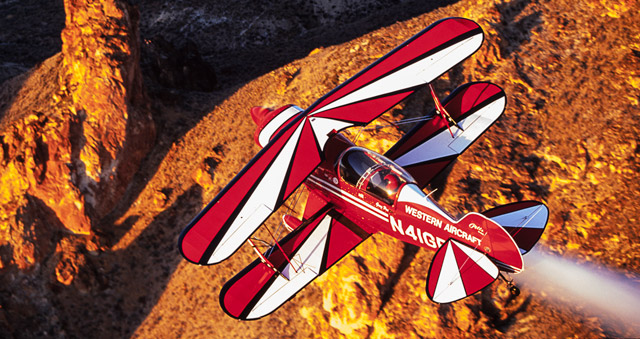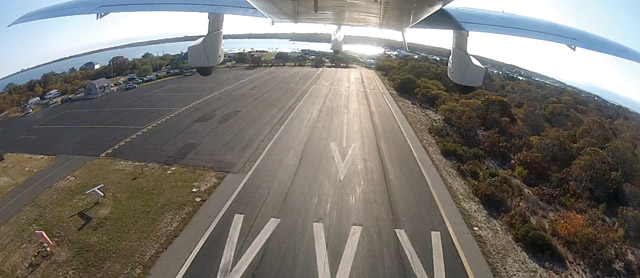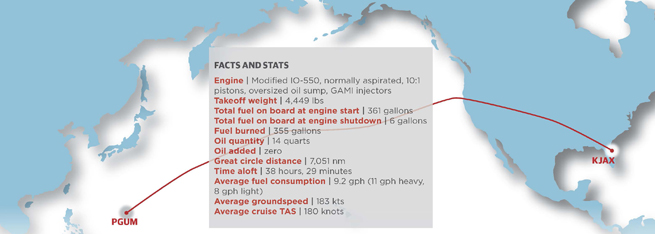Pilot Briefing
News from the world of general aviation
Test Pilot By Barry Schiff
- What was the first production military aircraft, the first production jetliner, and the first production business jet to incorporate a digital electronic (fly-by-wire) flight-control system?
- Mentally calculate (without using pencil and paper) the distance between the equator and the True South Pole.
- Pan American Airways inaugurated trans-Pacific service using a four-engine Martin M–130 flying boat, China Clipper, on November 22, 1935. The flight to Manila originated in San Francisco and made stops in Honolulu, Midway Island, Wake Island, and Guam. Who was the navigator?
- How did the Piper Cub come to be called a Cub?
- A wet wing is when the wing skin serves as the fuel tank, which eliminates the need for separate fuel tanks or bladders. What was the first production airplane to have wet wings?
- True or False? A typical carbureted engine fails during cruise flight because of fuel starvation. Manifold pressure will not change but can be reduced by closing the throttle.
- From reader John Schmidt: Most pilots would guess correctly that the United States has more airports (14,700) than any other country, but what country comes in second?
- A pilot’s blood will boil in unpressurized flight at approximately
a. 56,000 feet.
b. 63,000 feet.
c. 70,000 feet.
d. 77,000 feet.
Luscombe pilot challenges peers to May 19 flight
First it was the Swifts—now it’s the Luscombes. If you fly one of these classic taildraggers, you are cordially invited to team up with other Luscombe pilots around the world on May 19 and take to the skies.
That’s the date that organizer Barry Perkins of Monterey, California, has dubbed “A Day of Silvaire Disobedience” (get it?). “Our goal is to safely document all personal flights made that day by having pilots worldwide submit their flight stats, photos, and times for recording,” he said.
If you fly a Luscombe on May 19, send your information to Perkins and put “Silvaire Disobedience” in the subject line. Include your name, aircraft N number, model, takeoff and landing, universal times, locations, and a small photo attachment.
Nominations open for education award
Know an outstanding teacher who takes an innovative approach to aerospace education? Nominate him or her for the twenty-seventh annual A. Scott Crossfield Aerospace Education Teacher of the Year competition.
The event awards a $5,000 cash stipend and is open to current classroom teachers in kindergarten through grade 12. Entrants will be judged on their effectiveness, creativity, and ability to maintain high standards for students and themselves with aerospace as part of the core subject matter. The annual competition is sponsored by the National Aviation Hall of Fame. It is named in honor of the naval aviator, aerospace engineer, and test pilot who was the first man to successfully fly at speeds above Mach 2 and Mach 3. Crossfield was inducted into the National Aviation Hall of Fame in 1983.
The 2012 recipient was Jim McCarter of Kokomo, Indiana, whose elementary school classroom is a mock space shuttle. Children who “want to be in your classroom are going to show up, have good behavior, and are going to learn something,” he said.
The deadline for nominations is June 1. For more information and submission forms, see the website or call 888/383-1903, extension 11. The recipient must be able to attend the NAHF’s fifty-first annual enshrinement ceremony on October 4 in Dayton, Ohio.
Pitts look-alike to be offered as LSA
‘It may look like a Pitts, but he can’t call it a Pitts’
By Alton K. Marsh
Renegade Light Sport, relocated to Fort Pierce, Florida, has dropped its offering of the 4-G Polish-built Renegade FK–12 Comet aerobatic Light Sport aircraft (LSA) in favor of two new biplane LSA models based on the famous Pitts S–2 airframe. The new models are the single-seat Renegade LS1 and the two-seat LS2. The company cited difficulties with the European manufacturer and its distribution system as reasons for dropping the FK–12.
“Renegade plans on utilizing state-of-the-art carbon fiber internal wing structure with a Ceconite fabric covering that has proven to be the lightest and strongest method of fabrication for this small but mighty aircraft. The Renegade will have a much wider cabin and superior weight-to-horsepower ratio,” said Doc Bailey, owner and CEO of Renegade Light Sport LLC. He also will use carbon fiber to cover the steel-tube airframe.
Talks were in progress late last year between Bailey and Aviat Aircraft in Afton, Wyoming, which builds the wooden Pitts S–2. “He can design any type of aircraft he likes, and it may look remarkably like a Pitts, but he can’t call it a Pitts,” Aviat President Stu Horn said. He said he is still open to a joint venture but said talks have not continued.
There are also plans to use the new models for a new series of pylon races based on the former Red Bull racing series. Aircraft enter the pylon course at low altitude, one at a time, to compete for the best time through the course.
The fully aerobatic models will be powered by the Lycoming AEIO-233 engine, and will be capable of 124 horsepower. The LS1 is ready to begin construction, with the LS2 model expected to be completed late in the year.
Email [email protected].
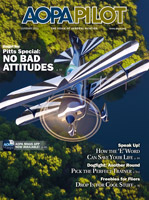
Favorite covers
In a recent AOPA ePilot poll, readers told us that the January 2012 cover, featuring a Pitts Special, was their favorite. We redesigned the magazine in June and that cover—with July and December—were our runners-up.
Test Pilot Answers
- The Avro Canada CF–105 Arrow (1958), Concorde (1969), and the Dassault Falcon 7X (2005).
- A nautical mile is equal to a minute of latitude, which means that there are 60 nm separating each degree of latitude. Because there are 90 degrees of latitude between the equator and either pole, the distance between them must be 60 times 90, or 5,400 nm. The distance around the Earth, therefore, is four times 5,400, which is 21,600 nm.
- Most pilots probably can name only one navigator, Fred Noonan, and this would be the correct answer. He also was Amelia Earhart’s navigator and became famous when the pair disappeared in the Pacific near Howland Island on July 2, 1937.
- The airplane was originally powered by a 20-horsepower, two-cylinder Brownback “Tiger Kitten” engine. Because a tiger kitten is a cub, the company’s accountant, Gilbert Hadrel, was inspired to call the little airplane a Cub.
- The Consolidated PBY flying boat (and amphibian) was built during the 1930s and 1940s. It was one of the most widely used multirole aircraft of World War II and served with every branch of the U.S. armed forces (as well as the air forces and navies of numerous other nations).
- True. The windmilling propeller causes the engine to continue turning and ambient atmospheric pressure is allowed to fill the cylinders as long as the throttle is open. Closing the throttle restricts air from entering the engine and would reduce manifold pressure.
- With 3,365 airports, Brazil is a distant second. With 2,743 airports, Russia comes in third.
- (b) Also, a given volume of air taken from sea level to this altitude would expand to 14.7 times its original size.
Tower closings hit 37 states
Budget sequestration affects ATC
By Alton K. Marsh
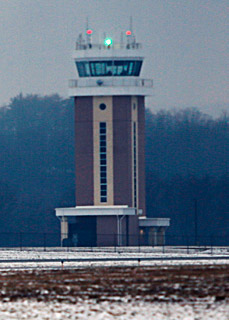
The announced closings of 149 contract air traffic control towers are to be completed by May 5. The FAA was forced by budget sequestration to chop $600 million from its budget, or 5 percent.
The FAA said it was closing the towers based on activity levels, with the first group to close having fewer than 1,000 commercial operations in fiscal year 2012. A second group had fewer than 2,500 commercial operations. The FAA estimates that the tower closures will save the agency about $32.8 million in fiscal year 2013.
AOPA had pointed out that contract towers operate less expensively than those run by the federal government. A last-ditch amendment in the Senate to keep the towers open failed.
In three cases, including at Frederick, Maryland, where AOPA has its headquarters, towers recently opened and built with money specifically intended to stimulate the economy were closed. The remaining two are in the Miami and St. Petersburg, Florida, areas.
Hardest hit is Florida with 14 closures, Texas with 13, and California with 11. Wisconsin and Connecticut has six each, while Washington, Maryland, Kansas, Illinois, Massachusetts, North Carolina and Georgia have five closures each.
One of three companies operating contract towers, RVA Robinson Aviation, operated 96 towers before closure, but only 38 afterward. Employment at RVA was expected to drop from 560 to approximately 220. “It’s a setback, and a big one. We’ll regroup and push forward,” said Charlie Dove, president of RVA. Even if a solution is found in Congress to end budget sequestration, one official did not expect the towers to reopen in 2013. However, he said local communities will likely maintain tower equipment, keeping the tower capable of reopening.
Some of the airports losing towers also lost the business of larger corporate jets because of company policy. In the case of Frederick, Maryland, three or four large jets were expected to drop Frederick as a destination, resulting in the loss of $6,000 in fuel sales each month. A Cessna Citation X that bought 1,200 gallons of fuel in one order three weeks prior to the tower closure was not expected to continue using Frederick in the future.
For more information check AOPA Online.
Doolittle Tokyo Raider dies at 96
Tom Griffin was a navigator on the raid
By Alyssa J. Miller
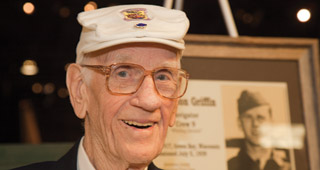
Thomas C. Griffin, a navigator on Crew No. 9 during the famed April 18, 1942, raid on Japan, died February 26 at the age of 96. Griffin was one of four Doolittle Tokyo Raiders who attended the seventieth reunion of the group in 2012 at Dayton, Ohio. (The fifth remaining Raider, Robert L. Hite, was unable to attend the Dayton event.) The event featured a gathering of North American B–25 Mitchells and a flyover of 20 of the aircraft in loose formation.
Born on July 10, 1917, in Green Bay, Wisconsin, Griffin was commissioned on July 15, 1939. As a navigator on the Tokyo raid, led by James H. “Jimmy” Doolittle, Griffin planned the course for his B–25’s crew from 650 miles out to sea on the USS Hornet. “On this particular mission, it was more or less dead reckoning,” Griffin told AOPA in 2012 as he recalled using wind information and a magnetic compass to figure his course (“Secret Mission” October 2012 AOPA Pilot). His calculations showed they would have to ditch 200 to 300 miles off the coast of China, but a change in the winds allowed the crew to bomb the Tokyo Gas and Electric Co. and make it to China’s mainland before bailing out.
Griffin returned to the United States after the Tokyo raid and joined the crew of a B–26 in North Africa later in World War II. He survived a crash on one assignment and a bailout on another. Griffin spent most of the final two years of World War II as a prisoner of war in Germany.
Email [email protected].
A letter from the Chairman of the Board
Fellow AOPA members,
AOPA has begun the search for the fifth president of the association. We are beginning a national search for a leader who will continue to lead the fight for general aviation in Washington, D.C., in your home state, and at your airport.
The Board of Trustees, a group of volunteers who all fly regularly for business and recreation, has begun the process to identify our next president. The natural question arises: Who are we looking for? The selection process is not an easy one; unlike most corporate searches, we must narrow the candidates to include only pilots. The candidate must be an outgoing, passionate aviator who believes in the critical value GA brings to our country and citizens. The candidate also must be an experienced businessperson who can lead and grow the world’s largest aviation association. The candidate must be able to articulate and fight for our cause and beliefs in Washington, D.C., and in all 50 state capitals. The candidate needs to fight for our rights with an ever-burdening regulatory structure that has grown substantially since the tragic events of 9/11. Where the FAA was once the primary regulator, we now have agencies we did not work with before 9/11—like the Department of Homeland Security, the Federal Communications Commission, and the Environmental Protection Agency—that are introducing policies or considering proposals that will limit our freedom to fly…and this does not include state and local authorities now positioning themselves as “protectors” of the public from GA aircraft.
Over the past several years, Craig’s seasoned Washington hand helped build the GA Caucus—the single most important bulwark against the current shenanigans on Capitol Hill; AOPA has continued to successfully beat back user fees at the federal level; we have fought against state-level GA tax increases and won numerous tax cuts that, when combined, save our members more than $100 million a year in state taxes and fees; and we actively support local airport efforts through the work of seven full-time regional managers and more than 2,500 Airport Support Network volunteers across the country. We’ve been focusing efforts on the threat of massive FAA budget cuts that could close more than 200 control towers, restrict weather and flight services, allow the navigation system to deteriorate, and derail aircraft certification.
Avgas prices have risen from an average of $4.44 per gallon in 2007 to $6.62 today. For most, new single-engine aircraft are prohibitively expensive because of the ever-increasing costs of certification and declining production levels, thereby greatly increasing the overhead costs per aircraft. Here at AOPA, we are not immune. We draw our membership from the pilot population, which having stood at 827,000 in 1980, is down to 610,000 today.
As many of you know, AOPA’s revenues are derived from three primary sources: membership dues; advertising in AOPA Pilot magazine and other media properties; and revenue from products and services such as the credit card, Pilot Protection Services, and insurance services. Membership dues remained unchanged from 1990 until 2010 when we raised them $6 per year, a 15-percent increase. During that period of time, the consumer price index of all goods and services increased 76 percent. Dues make up only 30 percent of our revenue. And once the economic downturn took hold, we also saw advertising in our publications fall greatly.
We have worked hard to bring down our operational costs for 2013 while not sacrificing the day-to-day work we do on advocacy. You will also see AOPA concentrate on providing revenue-generating services that bring more people into aviation, increase access to affordable aircraft, and grow the active pilot community. These initiatives will be focused toward areas in which we have already provided services in the past and allow us to keep the membership dues as low as possible.
Through deliberate and careful stewardship, AOPA has reserves of $80 million invested in a diversified portfolio of investments. This may seem like a great deal of money, and it is, but let’s take a look at its importance in the coming years. At its current levels, the reserves provide $3.2 million of revenue that we do not need to harness from membership dues or other initiatives. Additionally, when GA faces a major threat such as we saw after 9/11 or with user fees, these savings provide the ready reserve to fight battles on a national scale. Finally, strong not-for-profit organizations should have reserves equal to or greater than their annual revenues, a position that AOPA occupies.
So as we thank Craig for his hard work, your Board is looking for one of you to lead us in the years ahead. We represent all of general aviation, but we will not lose focus on our core member, the pilot who enjoys flying his owned or rented piston single as many hours as he or she can afford. A patriot that is growing weary of the overzealous regulation of this wonderfully American success story. A person who will fight for your freedom to fly. Someone who understands how prohibitive the cost of flying has become.
We on the board love to fly as much as you do. I have two boys ages 13 and 16; my greatest joy will be to have them participate in this amazing way of life. You can be assured that AOPA will focus, focus, focus on keeping this generation in the air and providing the opportunity to allow our children to experience the joy of flight.
I appreciate and value your membership. You are the only reason we enjoy the freedom to fly.
Sincerely,
Bill Trimble, chairman,
AOPA Board of Trustees
A great place to relax
Beachside airport has past, uncertain future
By Jim Moore
Helen Gil can spin a good yarn. She’ll tell you all about the time musician Ray Charles stopped by; or about the old fire truck once kept handy to give rides to and from the end of the runway, where a short trail through dunes topped with beach plums and blueberry bushes leads to a white sand beach. Visitors would hoist a flag to alert the airport staff they were ready for pickup. Today, a cell phone gets you the same result: a ride down the taxiway that parallels Montauk Airport’s 3,400-foot runway. You might wait a few minutes if it’s busy, but the ride will come. There are still showers to be had in the tiny terminal with wood-shingle siding on the outside, and scores of photos on the inside taken in days gone by—all by Gil, the airport manager now as much a part of this airport as anyone.
There are four seafood restaurants within half a mile; on a late-season visit, The Inlet, owned by six of the many commercial fishermen that ply the waters off of Montauk on New York’s Long Island is the last one still open for the year. The fish is as good as you might expect, and as fresh as can be: Montauk is the easternmost point of land in New York and the state’s busiest fishing port, according to real estate agent Timothy J. Griffin of Prudential Douglas Elliman Real Estate, who gave a tour and talked up the many virtues of an airport that has drawn pilots since 1957—but may be nearing the end of its run.
Griffin said recently that efforts to publicize the airport—all 37 acres of it, listed for $18 million—have yet to draw an offer, and the owners are exploring subdivision. Montauk has had federally funded improvements, including a resurfaced runway in 2009, so it must remain an airport until at least 2019.
Meanwhile, a short cab ride will get you into town, where any number of shops, restaurants, and other attractions await. A little farther out, the historic Montauk Point Lighthouse has a visitor’s center in season and breathtaking views any time. There are vineyards, horseback riding, and other things to see and do nearby.
“It’s a great little fishing community, still,” Gil said. “Even though we’ve kind of been Hamptonized this year. We’re not a Hampton.”
The airport has no fuel—the tanks had to come out years ago—and no repair services available. A $17 landing fee (bring cash) gets you a spot on a ramp that Gil must sweep frequently to clear off the shells dropped by seagulls using the convenient expanse of asphalt to open their lunch. Jeff Melagrano, a pilot who has made regular visits since 1978, said he is among those hoping that somehow, some way, it will remain an airport in decades to come. “It’s just a great place to relax, do nothing, and watch the ocean,” he said.
Email [email protected].
Fly-outs made possible by Enterprise Rent-A-Car.
If you go
Montauk Airport (MTP)
Montauk, New York
631-668-3738
Airport has no gas and no repair services. $17 cash landing fee.
Rental cars: www.aopa.org/cars
866-315-9155
Guam to JAX—nonstop
World distance record for aircraft in its weight category
By Dave Hirschman
When Bill Harrelson wanted to prove the long-range performance of his kitbuilt Lancair IV, he flew it from Indiana to Hawaii—a warm-up for a much longer flight. On March 1, Harrelson landed his Lancair in Jacksonville, Florida, after a 38.5-hour nonstop flight from Guam.
The Lancair IV was extensively modified during construction for extremely long-range, potentially record-setting flights. It can carry up to 361 gallons of avgas, and is powered by a normally aspirated modified IO-550 engine. The panel is a combination of steam gauges, a Garmin 480 GPS/com, and a two-screen PFD/MFD/engine monitor from Grand Rapids Technologies.
“To have an airplane with this kind of speed and range, you have to build it for that purpose from the very beginning,” said Harrelson, of Fredericksburg, Virginia. It has no anti-ice system, no turbocharging, no rear seats, no air conditioning, no speed brakes, and no external steps.
Harrelson’s route to Jacksonville took him north of Hawaii, and he made landfall over Northern California. He considered turning back to Guam when the display screen on his TruTrak autopilot went dark one hour into the flight, but the autopilot was functioning correctly so he continued. He flew through two nights, drank Gatorade and water, and ate protein bars during the marathon flight. He exercised hourly by stretching and contracting his muscles. He climbed from 7,000 feet to 17,000 feet over Colorado as the airplane got lighter. His oxygen regulator malfunctioned, and he had to bypass it by connecting the air hose directly to the tank and breathing through his mouth.
The fuel tanks in the airplane are plumbed to a single header tank that feeds the engine, and a sight gauge showed fuel remaining. He landed with six gallons left, enough for 45 minutes of flying at his low-cruise power setting.
Email [email protected].
Fuller to step down as AOPA president and CEO
Departure set for later this year
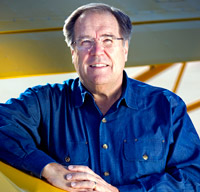
AOPA President Craig Fuller has announced he will step down from his position and from the Board of Trustees. He will remain in his current role until a successor is ready to assume the position. The board will conduct a national search for his successor. Fuller, who took office January 1, 2009, is only the fourth president of AOPA since the association’s founding nearly 75 years ago.
Fuller, 62, made a five-year commitment to AOPA when he was appointed president. “I have flown since age 17, and flying has been part of my life ever since. I will always be grateful to the AOPA Board of Trustees for having given me the opportunity to serve the GA community and AOPA’s 385,000 members in a leadership position,” said Fuller. “It has been a privilege to work with my colleagues on a strong set of initiatives that have built on the decades of hard work by AOPA trustees and members of the management team. ”
“During his more than four years as president of AOPA, Craig served nobly and professionally. He has advocated strongly on behalf of the GA community in Washington, built bridges with the other aviation associations, improved member communications and generated promising ideas for tomorrow,” said Bill Trimble, chairman of the AOPA Board of Trustees. “We recognize the importance of finding a leader who can continue to inspire all of us in these challenging times. We are focused on finding a leader who shares our vision and convictions as well as the talent and capabilities necessary to achieve our goals.” Trimble, who has chaired the AOPA Board of Trustees since 2005, said the board has formed a search committee and retained an executive search firm.
